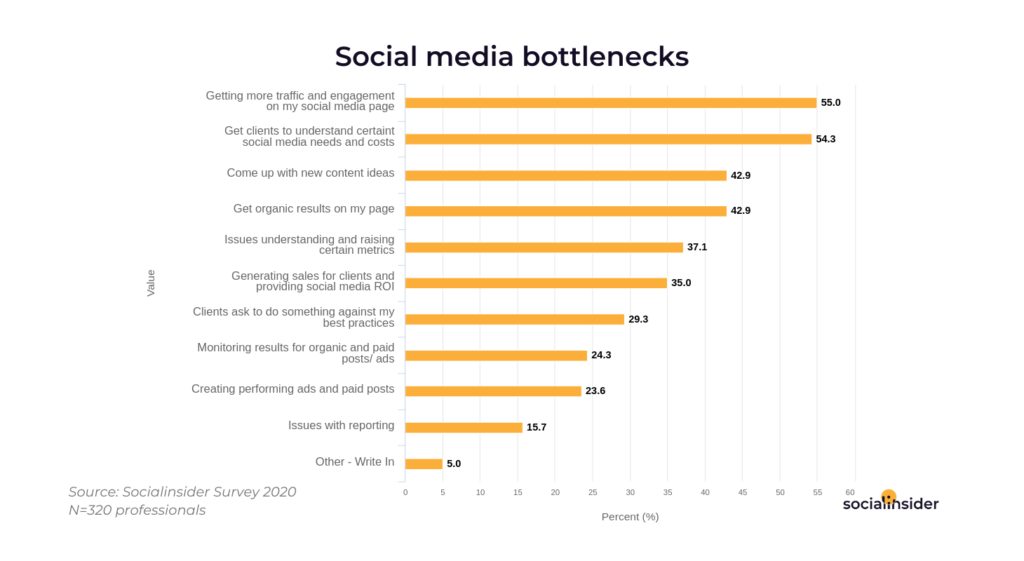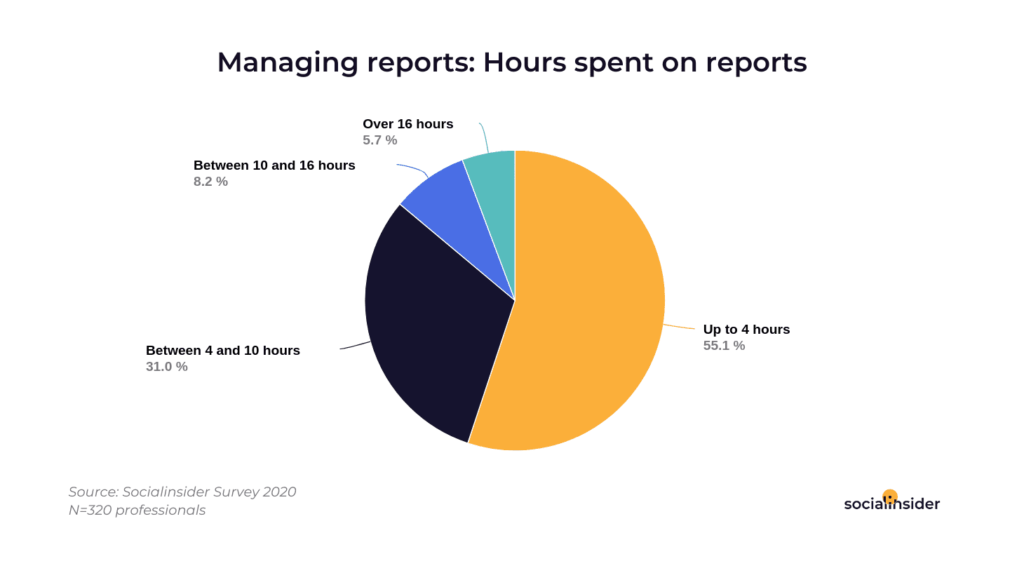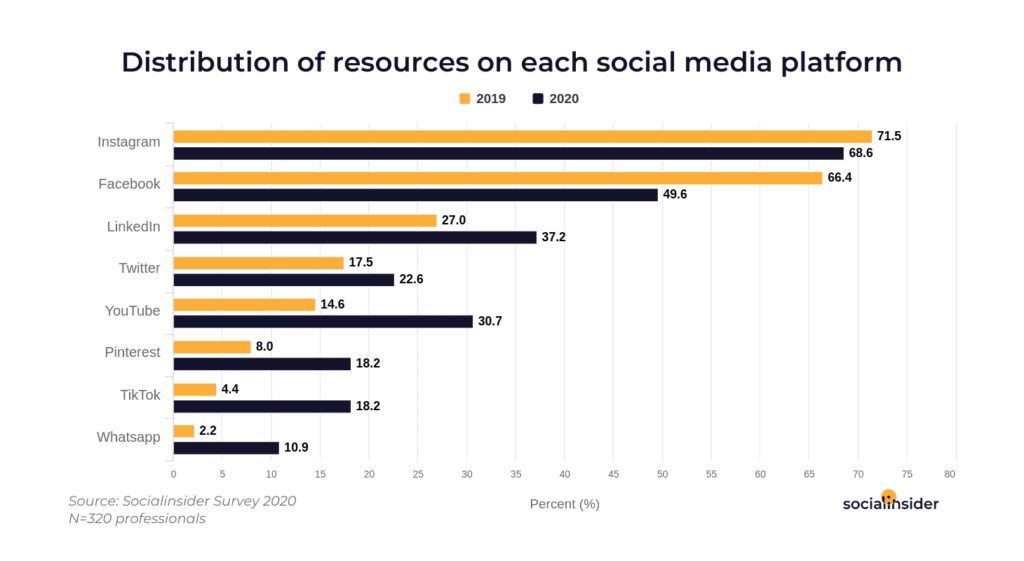Online marketing is capable of warp speed compared to historical advertising mediums like print, radio, and television. And in today’s landscape, where a health and economic crisis will shake the ground for many businesses, perfecting your business digitally will make a difference.
However, that doesn’t mean that social media marketing is without bottlenecks.
In fact, solving the puzzle of generating organic traffic, increasing engagement metrics, and selecting the best platforms can pose quite a challenge.
Add to this the time-consuming tasks of needs assessment, client communication, and social media reporting and it’s easy to see how social media specialists have their work cut out for them.
Luckily, custom-tailored content, creativity, and automation can all play a role in conquering social media bottlenecks.
But first, identifying those bottlenecks is essential.
Traffic and Engagement Labeled Primary Bottleneck by 55% of Survey Respondents
In a recent survey of 320 marketing and social media managers, executives, and account representatives conducted by Socialinsider, 55% of respondents identified “getting more traffic and engagement on my social media page” as number one among social media bottlenecks.

-
Common Social Media Bottlenecks
This was followed closely by the social media issues associated with managing client expectations. Many marketers encounter significant headwinds when it comes to convincing customers which social media platforms are appropriate, and what costs are fair and necessary.
The challenge in generating traffic, especially for smaller or new-to-market brands, is the lack of general brand recognition that is so critical to spawning organic social media traffic. The online sphere is vast especially when compared to limited social media budgets, so it becomes critical to make strategic bets about which social media investments, in terms of content and platform, will generate the greatest ROI.
Luckily, a small and fiercely loyal following of super fans who believe in the value of a product or service is often even better than a large, less passionate crowd, as shown by Kevin Kelly in “1,000 True Fans”.
The trick to building trust and creating momentum online is to craft tailor-made content that is actionable or inherently valuable to the target audience, and then sprinkle in small sponsored ad buys now and again.
These “true fans” will have a much higher conversion rate to subscribe or purchase and will re-post and retweet, or create new posts referencing hashtags, building a quality pipeline of future leads. This, in turn, will drive up engagement metrics as well as paving the way for higher satisfaction levels with social media clients.
Naturally, this only really works if the social media campaign adheres closely to the values of the company and product or service so that content genuinely resonates and feels authentic.
Communicating Social Media Needs vs. Costs to Clients a Close Second at 54%
Nearly as many survey respondents identified client communication issues as number one among social media bottlenecks. This isn’t really surprising given that all successful consultative relationships, whether internal to a company or external with an agency, rely upon education and proper expectation setting.
The person in charge of the purse strings may not always have realistic expectations about how far the budget will stretch. Because decision-makers often respond to stories or concrete examples, some agencies use case studies to align expectations with possible outcomes and demonstrate why some platforms work better for certain types of audiences, messaging or automation.
Advance research on the core audience and competitors, combined with clear documentation about KPIs and what success looks like, also help create confidence with social media clients as they telegraph competence and establish you as an authority.
51% of Marketers Deliver a Monthly Social Media Report to Clients, and 55% Spend up to 4 Hours on It
How will your clients or higher-ups know how a social media campaign is performing if you don’t tell them? Creating accurate, intelligible reports summarizing metrics and comparing outcomes to targets is a critical task for social media specialists.
Through this regular, referenceable communication, social media specialists and agencies build trust with other managers and project stakeholders, thus paving the way for improved and potentially better-funded relationships with social media clients going forward.
With that said, in order to preserve capacity for building new campaigns, one must create reasonable limits on time investment in building reports.

-
Hours Spent on Social Media Reporting
While 55% of survey respondents spent up to 4 hours per report, the remaining respondents spent more, including the smallest group of 6% who spent more than 16 hours per report. If you are spending more than 4 hours per report, it may be time to look for ways to automate and optimize.
Instagram Remains the Dominant Social Media Platform in 2020 at 68.6% but Slips From 2019’s 71.5%
As mentioned earlier, one of the priorities of social media specialists is generating the greatest ROI for each social media marketing dollar spent.
According to the social media survey, in 2019, 71.5% of the social media marketing resources were allocated to Instagram. However, the same respondents said that they plan to shift their distribution a bit in 2020 so that only 68.6% of marketing resources will be directed toward Instagram.
When looking at the total distribution of marketing dollars across the leading social media platforms, a trend toward broader diversification emerges. It also creates useful insights into the role that platform plays in creating or mitigating social media issues.
According to the survey, marketers’ investments will change in the following ways from 2019 to 2020:
- Instagram will drop from 71.5% to 68.6%
- Facebook will drop significantly from 66.4% to 49.6%
- LinkedIn investment will grow from 27% to 37.2%
- YouTube investment will double from 14.6% to 30.7%
- Pinterest investment will grow from 8.0% to 18.2%
- TikTok investment will make a healthy leap from 4.4% to 18.2%
- Whatsapp investment will grow by almost five times, from 2.2% to 10.9%

-
How Important Is Each Platform?
In social media marketing, trust is king. The keys to removing social media issues and conquering social media bottlenecks are creating authentic connections with the audience, setting expectations properly in advance with social media clients, showing results and demonstrating value through well-constructed social media reports, and investing in the right platforms for the job.
While much of this can feel like common sense, it’s also a concrete roadmap to more successful social media campaigns and stickier relationships with clients.
In an era where the social media landscape is built on shifting sands, especially in the context of an impending economical crisis, well-executed fundamentals still make a difference.
Do you have any other tips? Let us know what social media bottleneck bothers you the most!
social media table -DepositPhotos





